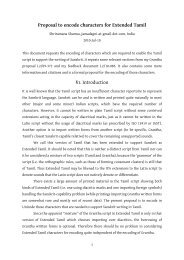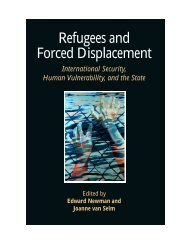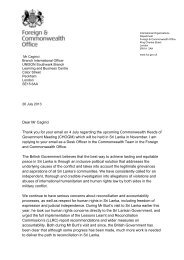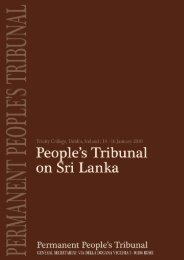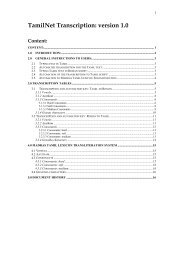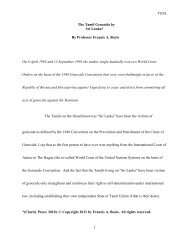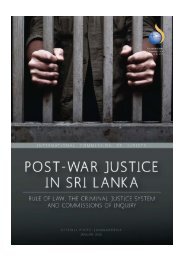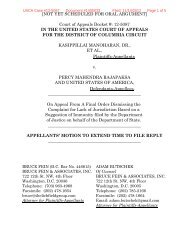The International Court of Justice and the Elements of the ... - TamilNet
The International Court of Justice and the Elements of the ... - TamilNet
The International Court of Justice and the Elements of the ... - TamilNet
You also want an ePaper? Increase the reach of your titles
YUMPU automatically turns print PDFs into web optimized ePapers that Google loves.
<strong>The</strong> European Journal <strong>of</strong> <strong>International</strong> Law Vol. 18 no. 4 © EJIL 2007; all rights reserved..........................................................................................<strong>The</strong> <strong>International</strong> <strong>Court</strong> <strong>of</strong><strong>Justice</strong> <strong>and</strong> <strong>the</strong> <strong>Elements</strong> <strong>of</strong><strong>the</strong> Crime <strong>of</strong> GenocideClaus Kreß *AbstractThis article seeks to identify <strong>the</strong> contribution made by <strong>the</strong> <strong>International</strong> <strong>Court</strong> <strong>of</strong> <strong>Justice</strong> (ICJor <strong>Court</strong>) to <strong>the</strong> international criminal law on genocide in its judgment <strong>of</strong> 26 February 2007on <strong>the</strong> Case concerning <strong>the</strong> Application <strong>of</strong> <strong>the</strong> Convention <strong>and</strong> Punishment <strong>of</strong> <strong>the</strong>Crime <strong>of</strong> Genocide (Bosnia <strong>and</strong> Herzegovina v. Serbia <strong>and</strong> Montenegro). 1 <strong>The</strong> overallassessment is as follows: while <strong>the</strong> judgment contains welcome clarification <strong>and</strong> consolidation<strong>of</strong> <strong>the</strong> international criminal law on genocide in several respects, <strong>the</strong> <strong>Court</strong> did not fullyapprehend <strong>the</strong> complex structure <strong>of</strong> <strong>the</strong> crime. Most importantly, <strong>the</strong> <strong>Court</strong> did not providea coherent explanation for its characterization <strong>of</strong> <strong>the</strong> atrocities committed in Srebrenica asgenocide. This note will not deal in any detail with <strong>the</strong> concept <strong>of</strong> a state act <strong>of</strong> genocide constitutingan internationally wrongful act, <strong>the</strong> ICJ’s factual findings, or its approach to admitting<strong>and</strong> weighing evidence.1 ␣ <strong>The</strong> <strong>Court</strong>’s Self-restraint Regarding <strong>International</strong>Criminal LawRegarding <strong>the</strong> sad chain <strong>of</strong> events that occurred in Bosnia <strong>and</strong> Herzegovina between1992 <strong>and</strong> 1995, <strong>the</strong> <strong>Court</strong> declared that it attaches ‘ <strong>the</strong> utmost importance to <strong>the</strong> …legal findings made by <strong>the</strong> ICTY ’ . 2 This statement <strong>of</strong> self-restraint would appear tobe part <strong>of</strong> <strong>the</strong> <strong>Court</strong>’s judicial policy in responding to what may be called <strong>the</strong> ‘ TadicDownloaded from http://ejil.oxfordjournals.org/ by guest on November 11, 2012* Pr<strong>of</strong>essor <strong>of</strong> Criminal Law <strong>and</strong> Public <strong>International</strong> Law, University <strong>of</strong> Cologne. Email: claus.kress@uni-koeln.de .1Case concerning <strong>the</strong> Application <strong>of</strong> <strong>the</strong> Convention on <strong>the</strong> Prevention <strong>and</strong> Punishment <strong>of</strong> <strong>the</strong> Crime <strong>of</strong> Genocide(Bosnia <strong>and</strong> Herzegovina v. Serbia <strong>and</strong> Montenegro) , Judgment <strong>of</strong> 26 Feb. 2007 (hereinafter ‘ Genocide ’ caseor judgment).2Ibid., at para. 403.EJIL (2007), Vol. 18 No. 4, 619−629doi: 10.1093/ejil/chm039
620 EJIL 18 (2007), 619−629challenge ’ .3<strong>The</strong> <strong>Court</strong> argues for roughly <strong>the</strong> following division <strong>of</strong> labour betweenitself <strong>and</strong> international criminal jurisdictions: where confronted with a preliminaryquestion <strong>of</strong> international criminal law, <strong>the</strong> <strong>Court</strong> will defer to <strong>the</strong> pertinent case law <strong>of</strong>an international criminal court; at <strong>the</strong> same time, <strong>the</strong> <strong>Court</strong> expects an internationalcriminal court to exercise a corresponding degree <strong>of</strong> self-restraint when faced with apreliminary question <strong>of</strong> general public international law.Such a division <strong>of</strong> labour is certainly desirable ins<strong>of</strong>ar as it promotes stability <strong>and</strong>legal certainty in <strong>the</strong> international legal order. However, <strong>the</strong>se ends must be delicatelybalanced against <strong>the</strong> need for substantive justice. In this regard, <strong>the</strong> Genocide judgmentcould benefit from some refinement. First, <strong>the</strong> contemplated division <strong>of</strong> labourshould not be mistaken by <strong>the</strong> <strong>Court</strong> as a licence to apply its own jurisprudence withoutresponding to legal challenges made to it. <strong>The</strong> <strong>Court</strong> must remain open to havingits case law challenged on legal grounds, <strong>and</strong> respond to <strong>the</strong>se challenges in a reasonedmanner. Applied to <strong>the</strong> Genocide judgment, this means that it was not good enough for<strong>the</strong> ICJ to hold that <strong>the</strong> applicable rule <strong>of</strong> attribution is ‘ effective control ’ based simplyon one <strong>of</strong> its previous judgments. Instead, <strong>the</strong> ICJ should have squarely addressed <strong>the</strong>legal challenge posed by <strong>the</strong> Applicant when it directed <strong>the</strong> <strong>Court</strong> to reconcile its rule<strong>of</strong> attribution with <strong>the</strong> case law <strong>of</strong> <strong>the</strong> Appeals Chamber <strong>of</strong> <strong>the</strong> <strong>International</strong> CriminalTribunal for <strong>the</strong> Former Yugoslavia (ICTY). 4Secondly, <strong>and</strong> similarly, <strong>the</strong> <strong>Court</strong> should not unquestionably accept internationalcriminal law jurisprudence emanating from international criminal tribunals if thiscase law is still evolving, is inconsistent, or is o<strong>the</strong>rwise open to serious challenge.Accordingly, <strong>the</strong> ICJ should not have adopted, without explanation, <strong>the</strong> ICTY’s positionthat genocide was committed in Srebrenica. At <strong>the</strong> same time, <strong>the</strong> ICJ must becommended for making findings on <strong>the</strong> concept <strong>of</strong> ‘ protected group ’ in <strong>the</strong> definition<strong>of</strong> genocide, <strong>and</strong> on <strong>the</strong> question <strong>of</strong> whe<strong>the</strong>r or not a policy <strong>of</strong> so-called ‘ ethnic cleansing’ amounts to genocide under international criminal law.2 ␣ <strong>The</strong> <strong>Court</strong>’s Failure to Clarify <strong>the</strong> Structure <strong>of</strong> <strong>the</strong> Crime <strong>of</strong>Genocide<strong>The</strong> structure <strong>of</strong> <strong>the</strong> crime <strong>of</strong> genocide poses quite a problem. 5 <strong>The</strong> definition lacksan explicit ‘ contextual ’ element <strong>and</strong> thus appears at first sight to be drafted from <strong>the</strong>perspective <strong>of</strong> <strong>the</strong> ‘ lone individual ’ seeking to destroy a protected group as such. However,it is clear that a single human being will not, except in <strong>the</strong> most exceptionalcircumstances, be capable <strong>of</strong> destroying a protected group or a part <strong>the</strong>re<strong>of</strong>.It is interesting to note that Raphael Lemkin already stated that ‘ [g]enocide isintended to signify a coordinated plan <strong>of</strong> different actions aiming at <strong>the</strong> destruction <strong>of</strong>essential foundations <strong>of</strong> <strong>the</strong> life <strong>of</strong> national groups, with <strong>the</strong> aim <strong>of</strong> annihilating <strong>the</strong>Downloaded from http://ejil.oxfordjournals.org/ by guest on November 11, 20123On this challenge see Kress, ‘ L’organe de facto en droit international public ’, 105 RGDIP (2001) 93.4Prosecutor v. Tadic, IT-94-1-A, judgment, 5 July 1999, at para. 120 ff.5For a more detailed analysis <strong>of</strong> <strong>the</strong> crime’s structure <strong>and</strong> elements see Kreß, ‘ <strong>The</strong> Crime <strong>of</strong> Genocide Under<strong>International</strong> Law ’, 6 Int’l Criminal L Rev (2006) 461.
<strong>The</strong> <strong>International</strong> <strong>Court</strong> <strong>of</strong> <strong>Justice</strong> <strong>and</strong> <strong>the</strong> <strong>Elements</strong> <strong>of</strong> <strong>the</strong> Crime <strong>of</strong> Genocide ␣␣␣621groups <strong>the</strong>mselves ’ . 6 This view mirrors <strong>the</strong> horrifying historical backdrop to <strong>the</strong> GenocideConvention 7 – <strong>the</strong> Holocaust – which is clearly reflected in <strong>the</strong> travaux préparatoires<strong>of</strong> <strong>the</strong> Convention. 8 It is not just <strong>the</strong> history <strong>and</strong> genesis <strong>of</strong> genocide, however, that cautionsagainst bringing <strong>the</strong> isolated perpetrator within <strong>the</strong> scope <strong>of</strong> <strong>the</strong> crime – exceptionalcircumstances apart. <strong>The</strong> crime’s status as a crime under general internationallaw also suggests that a clear international dimension must exist in respect <strong>of</strong> <strong>the</strong> underlyingconduct. This dimension will normally be absent in <strong>the</strong> case <strong>of</strong> <strong>the</strong> lone individual.Equally, categorizing <strong>the</strong> conduct <strong>of</strong> a lone individual as genocide would disconnect <strong>the</strong>crime <strong>of</strong> genocide from its historical roots as a crime against humanity. <strong>The</strong> requisitecontextual element <strong>of</strong> all crimes against humanity is that <strong>the</strong>y must occur as part <strong>of</strong> asystematic or widespread attack against any civilian population. 9 Such a disconnectionwould not only be highly implausible in light <strong>of</strong> <strong>the</strong> historical development <strong>of</strong> <strong>the</strong> law,but also for reasons <strong>of</strong> coherency within <strong>the</strong> corpus <strong>of</strong> crimes under international law.Indeed, it would be an oddity to dispense with a context requirement for <strong>the</strong> crime <strong>of</strong>genocide, while at <strong>the</strong> same time emphasizing <strong>the</strong> special stigma that attaches to thiscrime. 10<strong>The</strong> general exclusion <strong>of</strong> <strong>the</strong> lone perpetrator from <strong>the</strong> scope <strong>of</strong> <strong>the</strong> internationalcrime <strong>of</strong> genocide is broadly in line with <strong>the</strong> Genocide Convention case law, <strong>and</strong> subsequentpractice. For example, <strong>the</strong> District <strong>Court</strong> <strong>of</strong> Jerusalem inquired into <strong>the</strong> overallgenocidal campaign masterminded by <strong>the</strong> Nazi leadership, 11 <strong>the</strong> Chambers <strong>of</strong> <strong>the</strong> <strong>International</strong>Criminal Tribunal for Rw<strong>and</strong>a (ICTR) concerned <strong>the</strong>mselves with <strong>the</strong> question<strong>of</strong> whe<strong>the</strong>r or not <strong>the</strong>re was a ‘ nationwide ’ genocide in Rw<strong>and</strong>a in 1994, 12 <strong>and</strong><strong>the</strong> competent Trial Chamber in <strong>the</strong> groundbreaking ICTY judgment on <strong>the</strong> charge <strong>of</strong><strong>the</strong> commission <strong>of</strong> genocide in Bosnia considered it necessary to make a determinationregarding <strong>the</strong> overall ‘ criminal enterprise ’ . 13 This mode <strong>of</strong> analysis was endorsedby states parties when <strong>the</strong>y adopted <strong>the</strong> <strong>Elements</strong> <strong>of</strong> Crimes under <strong>the</strong> Statute <strong>of</strong> <strong>the</strong><strong>International</strong> Criminal <strong>Court</strong> (ICC <strong>Elements</strong>). 14 <strong>The</strong> states parties decided to place <strong>the</strong>conduct <strong>of</strong> <strong>the</strong> individual perpetrator ‘ in <strong>the</strong> context <strong>of</strong> a manifest pattern <strong>of</strong> similar6R. Lemkin, Axis Rule in Occupied Europe (1944), at 79 (emphasis added).7Convention on <strong>the</strong> Prevention <strong>and</strong> Punishment <strong>of</strong> <strong>the</strong> Crime <strong>of</strong> Genocide, 9 Dec. 1948 (entry into forceon 12 Jan. 1951), 78 UNTS 277.8In that respect, reference is made to <strong>the</strong> Summary Records <strong>of</strong> <strong>the</strong> meetings <strong>of</strong> <strong>the</strong> Sixth Committee <strong>of</strong> <strong>the</strong>General Assembly, UNGAOR, 6th Committee, 3rd session, 1948.9See in particular Art. 7 <strong>of</strong> <strong>the</strong> ICC Statute as <strong>the</strong> first comprehensive codification <strong>of</strong> crimes againsthumanity.10In Prosecutor v. Krstic, IT-98-33-A, judgment, 19 Apr. 2004, at para. 36, <strong>the</strong> ICTY Appeals Chamberexpressed <strong>the</strong> following generally held view: ‘[a]mong <strong>the</strong> grievous crimes this Tribunal has <strong>the</strong> duty topunish, <strong>the</strong> crime <strong>of</strong> genocide is singled out for special condemnation <strong>and</strong> opprobrium ’. This mirrors <strong>the</strong>characterization <strong>of</strong> genocide as <strong>the</strong> ‘ crime <strong>of</strong> crimes ’ in Prosecutor v. Kamb<strong>and</strong>a , ICTR-97-23-S, judgment<strong>and</strong> sentence, 4 Sept. 1998, at para. 16.11Attorney-General <strong>of</strong> <strong>the</strong> Government <strong>of</strong> Israel v. Eichmann , Judgment <strong>of</strong> 12 Dec. 1961, 36 Int’l L Rep (1968) 79.12See <strong>the</strong> groundbreaking judgment in Prosecutor v. Akayesu , ICTR-96-4-T, judgment, 2 Sept. 1998, atpara. 469.13Prosecutor v. Krstic , IT-98-33-T, judgment, 2 Aug. 2001, at para. 549.14ICC-ASP/1/3, Pt. II,; pursuant to Art. 9 <strong>of</strong> <strong>the</strong> ICC Statute, <strong>the</strong> <strong>Elements</strong> <strong>of</strong> Crimes are to assist <strong>the</strong> <strong>Court</strong>in <strong>the</strong> interpretation <strong>and</strong> application <strong>of</strong> Arts 6, 7, <strong>and</strong> 8.Downloaded from http://ejil.oxfordjournals.org/ by guest on November 11, 2012
622 EJIL 18 (2007), 619−629conduct ’ as long as such a perpetrator’s conduct cannot ‘ itself effect such destruction’ .15As one negotiator confirmed, this ‘ quasi-contextual element ’ was ‘ introducedto avoid <strong>the</strong> view expressed in <strong>the</strong> Jelisic case that genocide could be committed bya single individual ’ . 16 Against this backdrop, it is surprising how easily <strong>the</strong> ICTY’sAppeals Chamber concluded that this ‘ definition adopted in <strong>the</strong> <strong>Elements</strong> <strong>of</strong> Crimes didnot reflect customary law ’ in 1995. 17 In doing so, <strong>the</strong> Appeals Chamber overlooked acrucial opportunity to clarify <strong>the</strong> admittedly complex structure <strong>of</strong> genocide.Despite correctly introducing a ‘ quasi-contextual element ’ to <strong>the</strong> crime <strong>of</strong> genocide,<strong>the</strong> ICC <strong>Elements</strong> still fail to explain how its reference to <strong>the</strong> ‘ manifest pattern <strong>of</strong> similarconduct ’ relates to <strong>the</strong> definition <strong>of</strong> <strong>the</strong> crime. It is submitted that <strong>the</strong> answer liesin recognizing that, for all practical purposes, 18 an individual perpetrator’s genocidalintent requires a genocidal campaign as an implicit point <strong>of</strong> reference. Without suchan objective point <strong>of</strong> reference, an individual, who lacks <strong>the</strong> means to single-h<strong>and</strong>edlyeffect a (partial) group destruction, cannot have a realistic genocidal intent. He,ra<strong>the</strong>r, only entertains a vain genocidal hope. This leads to <strong>the</strong> fundamental distinctionbetween collective <strong>and</strong> individual genocidal intent, which was so well expressedby <strong>the</strong> Trial Chamber in Krstic :[T]he Chamber emphasises <strong>the</strong> need to distinguish between <strong>the</strong> individual intent <strong>of</strong> <strong>the</strong> accused<strong>and</strong> <strong>the</strong> intent involved in <strong>the</strong> conception <strong>and</strong> commission <strong>of</strong> <strong>the</strong> crime. <strong>The</strong> gravity <strong>and</strong> scale <strong>of</strong><strong>the</strong> crime <strong>of</strong> genocide ordinarily presume that several protagonists were involved in its preparation.Although <strong>the</strong> motive <strong>of</strong> each participant may differ, <strong>the</strong> objective <strong>of</strong> <strong>the</strong> enterprise remains<strong>the</strong> same. In such cases <strong>of</strong> joint participation, <strong>the</strong> intent to destroy, in whole or in part, a groupas such must be discernible in <strong>the</strong> act itself, apart from <strong>the</strong> intent <strong>of</strong> particular perpetrators. 19<strong>The</strong> ICJ’s Genocide judgment afforded it <strong>the</strong> perfect opportunity to clarify <strong>the</strong> status <strong>of</strong>a collective genocidal act because <strong>the</strong> <strong>Court</strong> was concerned with <strong>the</strong> possible commission<strong>of</strong> genocide by a state . Unfortunately, this opportunity was missed. <strong>The</strong> <strong>Court</strong> didrecognize <strong>the</strong> possibility <strong>of</strong> a collective genocidal intent in <strong>the</strong>ory. 20 It failed, however,15See <strong>the</strong> last common Element <strong>of</strong> Genocide. <strong>The</strong> exception ‘ could itself effect ’ is — in <strong>the</strong> words <strong>of</strong>William Schabas —‘ little more than a sophomoric hypothèse d ’ école ’: ‘ Darfur <strong>and</strong> <strong>the</strong> “ Odious Scourge ”:<strong>The</strong> Commission <strong>of</strong> Inquiry’s Findings on Genocide ’, 18 Leiden J Int’l L (2005) 877.16Wilmshurst, ’ Genocide ’, in R. Cryer et al. (eds), An Introduction to <strong>International</strong> Criminal Law <strong>and</strong> Procedure(2007), at 177; in Prosecutor v. Jelisic , IT-95-10-T, judgment, 14 Dec. 1999, at para. 100, <strong>the</strong> ICTY heldthat it was ‘ a priori possible to conceive that <strong>the</strong> accused harboured <strong>the</strong> plan to exterminate an entiregroup without this intent having been supported by any organisation in which o<strong>the</strong>r individuals participated’; even <strong>the</strong> Jelisic Chamber was cautious enough, though, to add immediately that ‘ it will be verydifficult in practice to provide pro<strong>of</strong> <strong>of</strong> <strong>the</strong> genocidal intent <strong>of</strong> an individual if <strong>the</strong> crimes committed arenot widespread <strong>and</strong> if <strong>the</strong> crime charged is not backed by an organisation or a system ’: at para. 101.17Judgment, supra note 10, at para. 224.18Supra note 15.19Supra note 13, at para. 549.20Supra note 1, at para. 371. <strong>The</strong> ICJ recognized that a ‘ higher authority ’ may possess genocidal intent,whe<strong>the</strong>r within <strong>the</strong> VRS or <strong>the</strong> Republika Srpska, or at <strong>the</strong> level <strong>of</strong> <strong>the</strong> Respondent itself ’. This intent wasfound not to be made out on <strong>the</strong> facts, at para. 376. <strong>The</strong> ICJ never<strong>the</strong>less seemed as a matter <strong>of</strong> law toadmit <strong>the</strong> possibility <strong>of</strong> an ‘ intent on <strong>the</strong> part <strong>of</strong> <strong>the</strong> Respondent, ei<strong>the</strong>r on <strong>the</strong> basis <strong>of</strong> a concerted plan, oron <strong>the</strong> basis that <strong>the</strong> events reviewed above reveal a consistent pattern <strong>of</strong> conduct which could only pointto <strong>the</strong> existence <strong>of</strong> such intent ’.Downloaded from http://ejil.oxfordjournals.org/ by guest on November 11, 2012
<strong>The</strong> <strong>International</strong> <strong>Court</strong> <strong>of</strong> <strong>Justice</strong> <strong>and</strong> <strong>the</strong> <strong>Elements</strong> <strong>of</strong> <strong>the</strong> Crime <strong>of</strong> Genocide ␣␣␣623to shed light on <strong>the</strong> relevance <strong>of</strong> such a collective intent for <strong>the</strong> intent <strong>of</strong> individualperpetrators. Instead, when examining <strong>the</strong> various incidents <strong>of</strong> atrocities, <strong>the</strong> <strong>Court</strong>seemed to inquire into <strong>the</strong> possible genocidal intent <strong>of</strong> unnamed individual perpetratorsas though such intent could have existed in <strong>the</strong> absence <strong>of</strong> a collective genocidalact. 21 In adopting this mode <strong>of</strong> analysis, <strong>the</strong> <strong>Court</strong> made <strong>the</strong> same error as <strong>the</strong>Darfur Commission when it considered it possible that certain unnamed individualsacted with genocidal intent irrespective <strong>of</strong> <strong>the</strong> existence <strong>of</strong> a collective genocidal act. 22Instead, <strong>the</strong> <strong>Court</strong> should have made it clear that, under normal circumstances, <strong>the</strong>genocidal intent <strong>of</strong> <strong>the</strong> individual perpetrator presupposes his or her knowledge <strong>of</strong> acollective genocidal act.3 ␣ <strong>The</strong> <strong>Court</strong>’s Position on <strong>the</strong> Material <strong>Elements</strong>( Actus Reus )<strong>The</strong> Genocide judgment constitutes a welcome contribution to both <strong>the</strong> concept <strong>of</strong>‘ protected group ’ <strong>and</strong> <strong>the</strong> meaning <strong>of</strong> ‘ deliberately inflicting on <strong>the</strong> group conditions<strong>of</strong> life calculated to bring about its physical destruction in whole or in part ’ . A questionmark must be placed, however, beside <strong>the</strong> <strong>Court</strong>’s underst<strong>and</strong>ing <strong>of</strong> ‘ imposing measuresintended to prevent births within <strong>the</strong> group ’ .A ␣ <strong>The</strong> Concept <strong>of</strong> Protected GroupBased on <strong>the</strong> wording <strong>and</strong> <strong>the</strong> history <strong>of</strong> <strong>the</strong> definition <strong>of</strong> genocide, <strong>the</strong> <strong>Court</strong> rejecteda negative construction <strong>of</strong> <strong>the</strong> concept <strong>of</strong> ‘ protected group ’, which considers as aprotected group all individuals rejected by <strong>the</strong> perpetrators <strong>of</strong> <strong>the</strong> atrocities. 23 Thisis correct <strong>and</strong> nothing must be added to <strong>the</strong> compelling reasoning underlying thatposition. 24 It is worth adding, however, that <strong>the</strong> <strong>Court</strong>’s reasoning would seem to alsoexclude – albeit only by implication – a purely subjective concept <strong>of</strong> ‘protected group ’,meaning a conception <strong>of</strong> <strong>the</strong> group based on <strong>the</strong> views <strong>of</strong> <strong>the</strong> alleged group or perpetrators.<strong>The</strong> <strong>Court</strong> correctly recalled that ‘ <strong>the</strong> drafters <strong>of</strong> <strong>the</strong> Convention also gave closeattention to <strong>the</strong> positive identification <strong>of</strong> groups with specific distinguishing characteristicsin deciding which groups <strong>the</strong>y would include <strong>and</strong> which (such as politicalgroups) <strong>the</strong>y would exclude ’. 25 Such an underst<strong>and</strong>ing does not only require a positiveidentification <strong>of</strong> <strong>the</strong> group, but also an essentially objective one. 26 This st<strong>and</strong>ard doesDownloaded from http://ejil.oxfordjournals.org/ by guest on November 11, 201221See in particular paras 277, 319, 334, <strong>and</strong> 354.22Report <strong>of</strong> <strong>the</strong> <strong>International</strong> Commission <strong>of</strong> Inquiry on Darfur to <strong>the</strong> Secretary-General. Pursuant to SCRes. 1564, 18 Sept. 2004, Annex to Letter dated 31 Jan. 2005 from <strong>the</strong> Secretary-General addressed to<strong>the</strong> President <strong>of</strong> <strong>the</strong> Security Council, S/2005/60, 1 Feb. 2005, at para. 520; for a critique see Kress, ‘ <strong>The</strong>Darfur Report <strong>and</strong> Genocidal Intent ’, 3 J Int’l Criminal <strong>Justice</strong> (2005) 577.23For such a negative definition see Prosecutor v. Jelisic , supra note 16, at para. 70.24<strong>The</strong> pertinent passages <strong>of</strong> <strong>the</strong> judgment, supra note 1, are paras 193 – 196; <strong>the</strong> same position was adoptedby <strong>the</strong> ICTY’s Appeals Chamber in Prosecutor v. Stakic , IT-97-24-A, judgment, 2 Mar. 2006, at paras20 ff; for <strong>the</strong> same view see Kreß, supra note 5, at 473 ff.25Judgment, supra note 1, at para. 194.26Kreß, supra note 5, at 373 ff.
624 EJIL 18 (2007), 619−629not, however, preclude a court from taking into account <strong>the</strong> self-perception <strong>of</strong> a groupwhen it comes to borderline cases <strong>of</strong> ethnic groups, as in Rw<strong>and</strong>a <strong>and</strong> Darfur. 27 In fact,<strong>the</strong> <strong>Court</strong> duly notes that ‘ <strong>the</strong> parties essentially agree that international jurisprudenceaccepts a combined subjective-objective approach ’ . 28 In rejecting a negative concept<strong>of</strong> ‘ protected group ’ that is implicitly purely subjective, <strong>the</strong> Genocide judgment guardsagainst <strong>the</strong> transformation <strong>of</strong> genocide into an unspecific crime <strong>of</strong> group destructionbased on a discriminatory motive.B␣ Deliberately Inflicting on <strong>the</strong> Group Conditions <strong>of</strong> Life Calculated toBring about Its Physical Destruction in Whole or in PartOne <strong>of</strong> <strong>the</strong> most important aspects <strong>of</strong> <strong>the</strong> Genocide judgment is probably its clear distinctionbetween forcible deportation or expulsion, <strong>and</strong> <strong>the</strong> infliction <strong>of</strong> conditionscalculated to bring about a group’s physical destruction. 29 In this context, <strong>the</strong> <strong>Court</strong>cites with approval <strong>the</strong> ICTY Trial Chamber judgment in Stakic, where it was heldthat a ‘ clear distinction must be drawn between physical destruction <strong>and</strong> mere dissolution<strong>of</strong> <strong>the</strong> group ’, <strong>and</strong> that <strong>the</strong> ‘ expulsion <strong>of</strong> a group or part <strong>of</strong> a group does notin itself suffice for genocide ’. 30 <strong>The</strong> <strong>Court</strong> was correct to apply <strong>the</strong> narrow legal test <strong>of</strong>conduct capable <strong>of</strong> physically destroying members <strong>of</strong> <strong>the</strong> group, as opposed to ‘ merely ’removing <strong>the</strong>m or dissolving <strong>the</strong> group as an entity. <strong>The</strong> correctness <strong>of</strong> this st<strong>and</strong>ardis evidenced by use <strong>of</strong> <strong>the</strong> word ‘ physical ’ in <strong>the</strong> definition <strong>of</strong> <strong>the</strong> material element,<strong>and</strong> by <strong>the</strong> well-known rejection <strong>of</strong> Syria’s proposal that <strong>the</strong> Convention should containan expansive conception <strong>of</strong> genocide that includes forced mass exodus. 31 <strong>The</strong> ICC<strong>Elements</strong> ’ lamentable reference to ‘ systematic expulsion from homes ’ will have to beinterpreted in light <strong>of</strong> this.C␣ Imposing Measures Intended to Prevent Births within <strong>the</strong> Group<strong>The</strong> <strong>Court</strong> was referred by <strong>the</strong> Applicant to <strong>the</strong> occurrence <strong>of</strong> ‘ forced separations <strong>of</strong>male <strong>and</strong> female Muslims in Bosnia <strong>and</strong> Herzegovina, as systematically practisedwhen various municipalities were occupied by <strong>the</strong> Serb forces ’, <strong>and</strong> which ‘ in all probabilityentailed a decline in <strong>the</strong> birth rate <strong>of</strong> <strong>the</strong> group, given <strong>the</strong> lack <strong>of</strong> physical contactover many months ’. 32 <strong>The</strong> Bosnian claim that forcible separation <strong>of</strong> <strong>the</strong> sexes may33amount to genocidal conduct finds support in <strong>the</strong> ICTR’s Akayesu judgment. <strong>The</strong>re,Downloaded from http://ejil.oxfordjournals.org/ by guest on November 11, 201227Ibid., at 476 ff.28Judgment, supra note 1, at para. 191.29See in particular para. 190 <strong>of</strong> <strong>the</strong> Judgment, supra note 1.30Prosecutor v. Stakic , IT-97-24-T, judgment, 31 July 2003, at para. 519 (citing Kreß, ‘§220 a/§6 VStGB ’,in W. Joecks <strong>and</strong> K. Miebach (eds), Münchener Kommentar zum Strafgesetzbuch (2003), iii, at 653 ff); para.519 <strong>of</strong> <strong>the</strong> Trial Chamber’s judgment was referred to with approval in Prosecutor v. Krstic , supra note 10,at para. 33, <strong>and</strong> not challenged in Prosecutor v. Stakic on appeal, supra note 24, at para. 46.31Syria proposed <strong>the</strong> inclusion <strong>of</strong> ‘ imposing measures intended to oblige members <strong>of</strong> a group to ab<strong>and</strong>on<strong>the</strong>ir homes in order to escape <strong>the</strong> threat <strong>of</strong> subsequent ill-treatment ’ as a separate sub-para. <strong>of</strong> Art. II<strong>of</strong> <strong>the</strong> Genocide Convention, supra note 7; UN GAOR, 3rd session, 6th Committee, at 176 (note 1) <strong>and</strong>186 (vote).32Judgment, supra note 1, at para. 355.33Supra note 13.
<strong>The</strong> <strong>International</strong> <strong>Court</strong> <strong>of</strong> <strong>Justice</strong> <strong>and</strong> <strong>the</strong> <strong>Elements</strong> <strong>of</strong> <strong>the</strong> Crime <strong>of</strong> Genocide ␣␣␣625<strong>the</strong> Chamber interpreted <strong>the</strong> crime <strong>of</strong> genocide to encompass ‘ sexual mutilation, <strong>the</strong>practice <strong>of</strong> sterilization, forced birth control, separation <strong>of</strong> <strong>the</strong> sexes <strong>and</strong> prohibition <strong>of</strong>marriages ’ .34<strong>The</strong> ICJ rejected <strong>the</strong> Bosnian claim <strong>and</strong> noted ‘ that no evidence was providedin support <strong>of</strong> this statement ’ . 35 If this comment is meant to refer to <strong>the</strong> ‘ decline <strong>of</strong><strong>the</strong> birth rate ’ , <strong>the</strong> reasoning is flawed because <strong>the</strong> genocidal act in question does notrequire <strong>the</strong> actual prevention <strong>of</strong> births. Instead, an intention to effect a decline suffices.But perhaps <strong>the</strong> <strong>Court</strong> wished to note a lack <strong>of</strong> evidence regarding <strong>the</strong> requisite intent.In that case, though, one would have expected <strong>the</strong> <strong>Court</strong> to elaborate on <strong>the</strong> meaning<strong>of</strong> <strong>the</strong> word ‘ intended ’ in this particular context. At first sight, this may appear to bea ra<strong>the</strong>r peripheral observation. It will be shown, however, that <strong>the</strong> possible intent toreduce <strong>the</strong> birth rate <strong>of</strong> <strong>the</strong> group may be enormously significant in terms <strong>of</strong> how tocharacterize <strong>the</strong> atrocities committed in Srebrenica. 364 ␣ <strong>The</strong> <strong>Court</strong>’s View on Genocidal IntentRegarding genocidal intent, international criminal lawyers tend to think first <strong>and</strong> foremost<strong>of</strong> <strong>the</strong> alternative purpose - <strong>and</strong> knowledge -based approaches. This controversy isnot really addressed in <strong>the</strong> Genocide judgment. This is true, even though <strong>the</strong> term ‘ specificintent ( dolus generalis ) ’ is used throughout <strong>the</strong> judgment. 37 From a comparativecriminal law perspective, <strong>the</strong> term can carry quite different connotations. 38 Since <strong>the</strong>judgment is inconclusive regarding <strong>the</strong> said controversy, <strong>the</strong>re is no need to pursue<strong>the</strong> critique <strong>of</strong> <strong>the</strong> predominant purpose -based approach any fur<strong>the</strong>r in this article. 39Instead, <strong>the</strong> focus in this section will be on <strong>the</strong> <strong>Court</strong>’s contribution to <strong>the</strong> much moreimportant object <strong>of</strong> genocidal intent, that is, <strong>the</strong> destruction <strong>of</strong> part <strong>of</strong> a group.A ␣ (<strong>The</strong> Intent to) Destroy (a Group in Whole or in Part)As is well known, <strong>the</strong> crucial question is whe<strong>the</strong>r <strong>the</strong> concept <strong>of</strong> destruction extendsto <strong>the</strong> destruction <strong>of</strong> <strong>the</strong> group as a social entity, as was held by German courts. 40 Asis equally well known, <strong>the</strong> ICTY Trial Chamber in Krstic explicitly rejected <strong>the</strong> social34Ibid., at para. 507 (emphasis added).35Ibid., at para. 355.36Infra sect. 5.37Judgment, supra note 1, at para. 187.38Kreß, supra note 5, at 494.39But see Kress, supra note 22, at 565 ff; <strong>and</strong> Kreß, supra note 5, at 492 ff.40For <strong>the</strong> jurisprudence in <strong>the</strong> Jorgic case see ‘ Amtliche Sammlung der Entscheidungen des Bundesgerichtsh<strong>of</strong>s’, in 45 Strafsachen 81; upheld by <strong>the</strong> Bundesverfassungsgericht (Federal Constitutional <strong>Court</strong>)[2001] Neue Juristische Wochenschrift (NJW) (2001) 1850; for an analysis see Rissing-van Saan, ‘ <strong>The</strong>German Federal Supreme <strong>Court</strong> <strong>and</strong> <strong>the</strong> Prosecution <strong>of</strong> <strong>International</strong> Crimes Committed in <strong>the</strong> FormerYugoslavia ’, 3 J Int’l Criminal <strong>Justice</strong> (2005) 398. At <strong>the</strong> time <strong>of</strong> writing, <strong>the</strong> decisions in <strong>the</strong> Jorgic caseare being challenged before <strong>the</strong> European <strong>Court</strong> <strong>of</strong> Human Rights (ECtHR) for violation <strong>of</strong>, inter alia,Art. 7 <strong>of</strong> <strong>the</strong> European Convention on Human Rights; for a defence <strong>of</strong> <strong>the</strong> German case law see Werle,‘ German Jurisprudence on Genocidal Intent <strong>and</strong> <strong>the</strong> European Convention <strong>of</strong> Human Rights <strong>and</strong> FundamentalFreedoms ’, in K. Nuotio (ed.), Festschrift in Honour <strong>of</strong> Raimo Lahti (2007), 43.Downloaded from http://ejil.oxfordjournals.org/ by guest on November 11, 2012
626 EJIL 18 (2007), 619−629concept <strong>of</strong> group destruction, 41 a position that was upheld on appeal, 42 <strong>and</strong> followedby <strong>the</strong> Darfur Commission. 43 Still, <strong>the</strong> law was not, according to some, settled at <strong>the</strong>time <strong>of</strong> <strong>the</strong> Krstic judgment. For example, Judge Shahabuddeen dissented from <strong>the</strong>majority in <strong>the</strong> Krstic Appeals Chamber judgment <strong>and</strong> stated that, ‘ provided that<strong>the</strong>re is a listed act, <strong>the</strong> intent to destroy a group as a group is capable <strong>of</strong> being provedby evidence <strong>of</strong> an intent to cause <strong>the</strong> non-physical destruction <strong>of</strong> <strong>the</strong> group in whole orin part ’ . 44 As well, <strong>the</strong> ICTY Trial Chamber in Blagojevic held in quite confusing termsthat ‘ <strong>the</strong> physical or biological destruction <strong>of</strong> <strong>the</strong> group is <strong>the</strong> likely outcome <strong>of</strong> a forcibletransfer <strong>of</strong> a population when this transfer was conducted in such a way that <strong>the</strong>group can no longer reconstitute itself – particularly when it involves <strong>the</strong> separation<strong>of</strong> its members ’ . 45Against this backdrop <strong>of</strong> inconsistent case law (<strong>and</strong> in light <strong>of</strong> <strong>the</strong> pending challengebefore <strong>the</strong> European <strong>Court</strong> <strong>of</strong> Human Rights on <strong>the</strong> legality <strong>of</strong> <strong>the</strong> German caselaw), observers anxiously anticipated learning what position <strong>the</strong> ICJ would take on<strong>the</strong> issue. In addition, <strong>the</strong> <strong>Court</strong>’s factual finding that <strong>the</strong>re was no intent to physicallyor biologically destroy all Bosnian Muslims meant that <strong>the</strong> only way to find <strong>the</strong> occurrence<strong>of</strong> a nationwide genocide was by adopting a social concept <strong>of</strong> group destruction.<strong>The</strong> <strong>Court</strong> appears to have rejected this social conception in favour <strong>of</strong> a narrow onelimited to physical or biological group destruction:Nei<strong>the</strong>r <strong>the</strong> intent, as a matter <strong>of</strong> policy, to render an area ‘ ethnically homogeneous ’ , nor <strong>the</strong>operations that may be carried out to implement such policy, can as such be designated asgenocide: <strong>the</strong> intent that characterizes genocide is ‘ to destroy, in whole or in part ’ a particulargroup, <strong>and</strong> deportation or displacement <strong>of</strong> <strong>the</strong> members <strong>of</strong> <strong>the</strong> group, even if effected by force,is not necessarily equivalent to destruction <strong>of</strong> that group, nor is such destruction an automaticconsequence <strong>of</strong> <strong>the</strong> displacement. 46It is somewhat unfortunate that <strong>the</strong> clarity <strong>of</strong> this passage suffers – as is true <strong>of</strong> <strong>the</strong>whole paragraph – from a constant oscillation between genocidal intent <strong>and</strong> <strong>the</strong> conductelement <strong>of</strong> ‘ inflicting on <strong>the</strong> group conditions <strong>of</strong> life calculated to bring about itsphysical destruction in whole or in part ’ . In that respect, <strong>the</strong> least ambiguous applicationin <strong>the</strong> Genocide judgment <strong>of</strong> a narrow physical or biological concept <strong>of</strong> groupdestruction is where <strong>the</strong> <strong>Court</strong> was unable to find an intent to destroy regarding <strong>the</strong>siege <strong>of</strong> Sarajevo. It quotes with approval <strong>the</strong> holding <strong>of</strong> <strong>the</strong> ICTY Trial Chamber inGalic that ‘ <strong>the</strong> attacks on civilians were numerous, but were not consistently so intenseas to suggest an attempt by <strong>the</strong> SRK to wipe out or even deplete <strong>the</strong> civilian populationDownloaded from http://ejil.oxfordjournals.org/ by guest on November 11, 201241<strong>The</strong> Chamber stated that, ‘ despite recent developments, customary international law limits <strong>the</strong> definition<strong>of</strong> genocide to those acts seeking <strong>the</strong> physical <strong>and</strong> biological destruction <strong>of</strong> all or part <strong>of</strong> <strong>the</strong> group ’:Prosecutor v. Krstic , supra note 13, at para. 580.42Prosecutor v. Krstic , supra note 10, at para. 26.43Report, supra note 22, at paras 515, 517, 518, <strong>and</strong> 520.44Supra note 10, at para. 48 in conjunction with para. 55.45Prosecutor v. Blagojevic et al. , IT-02-60-T, judgment, 17 Jan. 2005, at para. 666; as was noted in Kreß,supra note 5, at 488. <strong>The</strong> Blagojevic judgment comes very close to precisely <strong>the</strong> German case law that wasrejected in Krstic; for a concurring view see Werle, supra note 40, at 45.46Judgment, supra note 1, at para. 190.
<strong>The</strong> <strong>International</strong> <strong>Court</strong> <strong>of</strong> <strong>Justice</strong> <strong>and</strong> <strong>the</strong> <strong>Elements</strong> <strong>of</strong> <strong>the</strong> Crime <strong>of</strong> Genocide ␣␣␣627through attrition ’ .47This narrow approach is correct, despite weighty opposing arguments.48 Contrary to what Judge Shahabuddeen believes, <strong>the</strong> interpretation <strong>of</strong> <strong>the</strong>word ‘ destroy ’ should not be disconnected from <strong>the</strong> list <strong>of</strong> genocidal acts . O<strong>the</strong>rwise,<strong>the</strong> conscious decision <strong>of</strong> <strong>the</strong> Sixth Committee to confine <strong>the</strong> international criminalization<strong>of</strong> genocide to an exhaustive list <strong>of</strong> five forms <strong>of</strong> attacks could be sidestepped.<strong>The</strong> destructive goal must <strong>the</strong>refore be <strong>the</strong> result <strong>of</strong> a generalized commission <strong>of</strong> oneor more <strong>of</strong> those acts that form <strong>the</strong> crime’s actus reus, <strong>and</strong> this seems to be precisely <strong>the</strong>position taken by <strong>the</strong> ICJ.B ␣ (<strong>The</strong> Intent to Destroy) a Group (in Whole or) in PartNot surprisingly, <strong>the</strong> <strong>Court</strong> took <strong>the</strong> words ‘ in part ’ to refer to a requirement <strong>of</strong> substantiality. <strong>The</strong> <strong>Court</strong> went on to say that ‘ <strong>the</strong> part targeted must be significant enough to49have an impact on <strong>the</strong> group as a whole ’. 50 While <strong>the</strong> <strong>Court</strong> recognized that <strong>the</strong> prominence<strong>of</strong> certain individuals may provide a qualitative justification to consider <strong>the</strong>mmembers <strong>of</strong> <strong>the</strong> protected group, <strong>the</strong> <strong>Court</strong> convincingly rejected <strong>the</strong> view espousedby <strong>the</strong> ICTY Trial Chamber in Krstic that a relevant part <strong>of</strong> <strong>the</strong> group must form a51‘ distinct entity ’. Finally, <strong>the</strong> <strong>Court</strong> seemed to accept <strong>the</strong> idea that <strong>the</strong> members <strong>of</strong>a group living within a geographically limited area may form a part <strong>of</strong> this group. In thisrespect, however, <strong>the</strong> <strong>Court</strong> held that ‘ <strong>the</strong> area <strong>of</strong> <strong>the</strong> perpetrator’s activity <strong>and</strong> controlare to be considered ’. Unfortunately, this reasoning is flawed because once again <strong>the</strong>lone perpetrator is <strong>the</strong> yardstick used by <strong>the</strong> <strong>Court</strong> to determine <strong>the</strong> scope <strong>of</strong> a contextualelement. 52 This kind <strong>of</strong> analysis fails to appreciate <strong>the</strong> crime’s collective nature. Inany event, <strong>the</strong> judgment’s considerations in abstracto, if taken toge<strong>the</strong>r, leave considerableroom for concretization.5 ␣ <strong>The</strong> Atrocities Committed in Srebrenica as Crimes <strong>of</strong>Genocide<strong>The</strong> ICJ had no difficulty, <strong>of</strong> course, in finding that acts <strong>of</strong> killing <strong>and</strong> <strong>of</strong> causing seriousbodily <strong>and</strong> mental harm had been committed in Srebrenica in July 1995. <strong>The</strong> crucialquestion was whe<strong>the</strong>r those acts had been committed with <strong>the</strong> intent to destroy apart <strong>of</strong> <strong>the</strong> protected group concerned, that latter group being <strong>the</strong> Bosnian Muslims. 53Downloaded from http://ejil.oxfordjournals.org/ by guest on November 11, 201247Prosecutor v. Galic , IT-98-29-T, judgment, 5 Dec. 2003, at para. 593, cited in Judgment, supra note 1, atpara. 328 (emphasis added).48For a more detailed analysis see Kreß, supra note 5, at 486 ff.49Judgment, supra note 1, at para. 198.50Ibid .51Prosecutor v. Krstic , supra note 13, at para. 590; for a critique see Kreß, supra note 5, at 491 (n. 154), citedin Judgment, supra note 1, at para. 200.52See supra sect. 2.53<strong>The</strong> Bosnian Muslims were characterized as a national group within <strong>the</strong> meaning <strong>of</strong> <strong>the</strong> Convention ( Prosecutorv. Krstic , supra note 10, at para. 15); <strong>the</strong> considerable difficulty in distinguishing national groupsfrom ethnic groups will not be pursued any fur<strong>the</strong>r in this note; but see Kreß, supra note 5, at 476.
628 EJIL 18 (2007), 619−629Following <strong>the</strong> ICTY Appeals Chamber in Krstic, 54 <strong>the</strong> <strong>Court</strong> considered <strong>the</strong> BosnianMuslims <strong>of</strong> Srebrenica to form a part <strong>of</strong> <strong>the</strong> Bosnian Muslim group, within <strong>the</strong> meaning<strong>of</strong> <strong>the</strong> crime’s definition. 55 Instead <strong>of</strong> giving reasons, <strong>the</strong> <strong>Court</strong> cited <strong>the</strong> followingpassage in <strong>the</strong> Krstic appeals judgment:<strong>The</strong> size <strong>of</strong> <strong>the</strong> Bosnian Muslim population in Srebrenica prior to its capture by <strong>the</strong> VRS forcesin 1995 amounted to approximately forty thous<strong>and</strong> people … Although this population constitutedonly a small percentage <strong>of</strong> <strong>the</strong> overall Muslim population <strong>of</strong> Bosnia <strong>and</strong> Herzegovinaat <strong>the</strong> time, <strong>the</strong> importance <strong>of</strong> <strong>the</strong> Muslim community <strong>of</strong> Srebrenica is not captured solely byits size. 56This way <strong>of</strong> dealing with a decisive question is very unsatisfactory indeed. This is all<strong>the</strong> more so because <strong>the</strong> quoted passage alludes to a qualitative criterion, but does notdefine it. One is thus left with <strong>the</strong> impression that <strong>the</strong> ICJ has <strong>of</strong>fered a purely quantitativethreshold: about 40,000 individuals forming about 3 per cent <strong>of</strong> <strong>the</strong> entire groupapparently sufficed. It must be seriously doubted whe<strong>the</strong>r <strong>the</strong> drafters <strong>of</strong> <strong>the</strong> GenocideConvention intended <strong>the</strong> crime’s scope to be so drastically exp<strong>and</strong>ed through <strong>the</strong>words ‘ in part ’ . <strong>The</strong> significance <strong>of</strong> <strong>the</strong>se words was hardly ever discussed during <strong>the</strong>negotiations. 57 That said, <strong>the</strong> Genocide judgment <strong>and</strong> <strong>the</strong> ensuing international acquiescenceconstitute a most important element <strong>of</strong> subsequent practice in support <strong>of</strong> suchan expansion. Incidentally, <strong>the</strong> Srebrenica precedent will also be <strong>of</strong> relevance for <strong>the</strong>scope <strong>of</strong> crimes against humanity. This is because it would seem illogical to apply arelatively higher quantitative st<strong>and</strong>ard to <strong>the</strong> element ‘ any civilian population ’ within<strong>the</strong> definition <strong>of</strong> this group <strong>of</strong> crimes.Whe<strong>the</strong>r <strong>the</strong>re was an intent to destroy <strong>the</strong> Muslim community in Srebrenicaremains a question. Interestingly, <strong>the</strong> <strong>Court</strong> approached <strong>the</strong> question from <strong>the</strong> perspective<strong>of</strong> collective activity. 58 This approach is correct, <strong>of</strong> course, but does not fit easilywith <strong>the</strong> <strong>Court</strong>’s simultaneous search for <strong>the</strong> genocidal intent <strong>of</strong> unnamed individualperpetrators as if no such collective campaign had been necessary. 59 This brings us to<strong>the</strong> burning question <strong>of</strong> what reasons were given by <strong>the</strong> <strong>Court</strong> in support <strong>of</strong> <strong>the</strong> conclusionthat <strong>the</strong>re was a collective intent to destroy <strong>the</strong> Srebrenica part <strong>of</strong> <strong>the</strong> BosnianMuslim group. Very sadly, <strong>the</strong> <strong>Court</strong> provided none. Instead, <strong>the</strong> <strong>Court</strong> was here againcontent with stating that it ‘ has no reason to depart from <strong>the</strong> Tribunal’s [<strong>the</strong> ICTY’s]determination ’ .60This, with all due respect, <strong>and</strong> in recognition <strong>of</strong> <strong>the</strong> <strong>Court</strong>’s judicialDownloaded from http://ejil.oxfordjournals.org/ by guest on November 11, 201254Prosecutor v. Krstic , supra note 10, at para. 15.55This means that <strong>the</strong> collective intent to destroy could not have been derived from <strong>the</strong> plan to kill, meaningphysically to destroy <strong>the</strong> group <strong>of</strong> 7,000 to 8,000 Muslim men in Srebrenica. This is because this groupwas only part <strong>of</strong> <strong>the</strong> identified part <strong>of</strong> <strong>the</strong> protected group.56Judgment, supra note 1, at para. 296, citing Prosecutor v. Krstic , supra note 10, at para. 15.57On <strong>the</strong> lack <strong>of</strong> discussion on <strong>the</strong> purported meaning <strong>of</strong> <strong>the</strong> words ‘ in part ’ during <strong>the</strong> negotiations seeKreß, supra note 5, at 489. For scholarly criticism <strong>of</strong> <strong>the</strong> risk <strong>of</strong> ‘ distorting <strong>the</strong> crime’s definition unreasonably’ through an overly generous interpretation <strong>of</strong> <strong>the</strong> words ‘ in part ’ see Schabas, ‘ Was GenocideCommitted in Bosnia <strong>and</strong> Herzegovina? First Judgments <strong>of</strong> <strong>the</strong> <strong>International</strong> Criminal Tribunal <strong>of</strong> <strong>the</strong>Former Yugoslavia ’, 25 Fordham Int’l LJ (2002) 45; Kreß, supra note 5, at 491.58Judgment, supra note 1, at paras. 292 ff.59Supra sect. 2, text accompanying note 20.60Judgment, supra note 1, at para. 295.
<strong>The</strong> <strong>International</strong> <strong>Court</strong> <strong>of</strong> <strong>Justice</strong> <strong>and</strong> <strong>the</strong> <strong>Elements</strong> <strong>of</strong> <strong>the</strong> Crime <strong>of</strong> Genocide ␣␣␣629policy to achieve international coordination by an exercise <strong>of</strong> judicial self-restraintin fields <strong>of</strong> ‘ lesser expertise ’ ,61is an entirely inappropriate approach to dealing with<strong>the</strong> key question <strong>of</strong> a contentious case. Instead, <strong>the</strong> <strong>Court</strong> had a duty to explain howa collective intent to destroy <strong>the</strong> Srebrenica part <strong>of</strong> <strong>the</strong> Bosnian Muslims could bereconciled with <strong>the</strong> concept <strong>of</strong> physical or biological group destruction to which <strong>the</strong>judgment generally adheres. Instead, it relied on <strong>the</strong> ICTY appeals judgment in Krstic ,which held that <strong>the</strong> atrocities committed in Srebrenica ‘ would inevitably result in <strong>the</strong>physical disappearance <strong>of</strong> <strong>the</strong> Bosnian Muslim population at Srebrenica ’ . 62 Here, physicaldisappearance means lasting expulsion, not destruction. Having adopted <strong>the</strong> narrowst<strong>and</strong>ard <strong>of</strong> physical or biological group destruction, <strong>the</strong> ICJ’s endorsement <strong>of</strong> thispassage is perplexing.Barring physical destruction, one wonders whe<strong>the</strong>r <strong>the</strong> existence <strong>of</strong> a collectiveintent to destroy <strong>the</strong> Bosnian Muslims in Srebrenica can be explained in some o<strong>the</strong>rway based on <strong>the</strong> narrow physical or biological interpretation <strong>of</strong> ‘ destruction ’ , whichis preferred. Perhaps more convincing reasoning can be found in <strong>the</strong> following passage<strong>of</strong> <strong>the</strong> Krstic appeals judgement, which <strong>the</strong> <strong>Court</strong> curiously did not cite:Evidence introduced at trial supported that finding, by showing that, with <strong>the</strong> majority <strong>of</strong>men killed <strong>of</strong>ficially listed as missing, <strong>the</strong>ir spouses are unable to remarry <strong>and</strong>, consequently,to have new children. <strong>The</strong> physical destruction <strong>of</strong> <strong>the</strong> men <strong>the</strong>refore had severe procreativeimplications for <strong>the</strong> Srebrenica Muslim community, potentially consigning <strong>the</strong> community toextinction. 63Quite clearly, this refers to <strong>the</strong> concept <strong>of</strong> biological destruction <strong>and</strong> it would appear tomake sense to think in that direction. Surprisingly, however, nei<strong>the</strong>r <strong>the</strong> ICTY Chambersin Krstic nor, as we have seen, <strong>the</strong> ICJ characterized <strong>the</strong> Srebrenica campaign as<strong>the</strong> (generalized) imposition <strong>of</strong> measures intended to prevent births within <strong>the</strong> group.Perhaps this failure constitutes <strong>the</strong> one missing element to a coherent explanation <strong>of</strong><strong>the</strong> atrocities committed in Srebrenica as genocide under international law.Concluding Observation<strong>The</strong> ICJ agreed with <strong>the</strong> ICTY Appeals Chamber in Krstic ‘ that <strong>the</strong> law condemns, inappropriate terms, <strong>the</strong> deep <strong>and</strong> lasting injury inflicted, <strong>and</strong> calls <strong>the</strong> massacre at Srebrenicaby its proper name: genocide ’ . 64 Indeed, <strong>the</strong> unspeakable atrocities committedin Srebrenica evince a feeling <strong>of</strong> horror in all <strong>of</strong> us. However, this feeling should notsilence <strong>the</strong> international criminal lawyer’s insistence on a compelling legal explanation<strong>of</strong> this most egregious crime.Downloaded from http://ejil.oxfordjournals.org/ by guest on November 11, 201261Supra sect. 1.62Judgment, supra note 1, at para. 293 (emphasis added), citing Prosecutor v. Krstic , supra note 10, at para.28, which in turn is a quotation from Prosecutor v. Krstic , supra note 13, at para. 595.63Prosecutor v. Krstic , supra note 10, at para. 28.64Judgment, supra note 1, at para. 293, citing Prosecutor v. Krstic , supra note 10, at para. 37.



